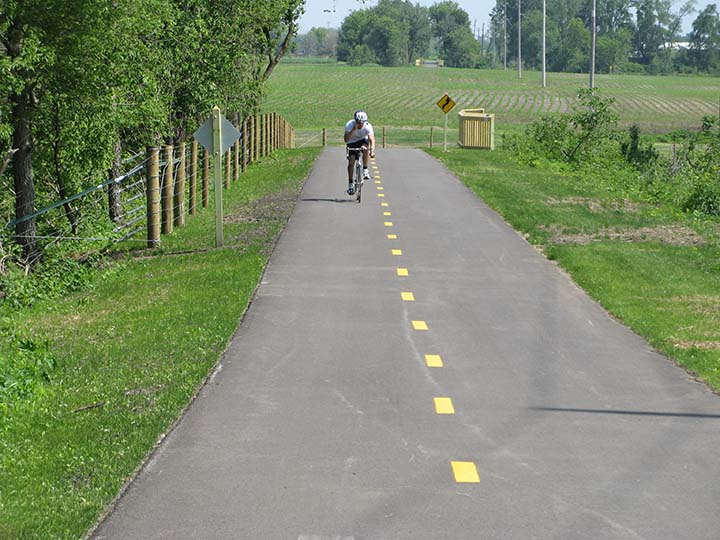Recreational Trails: Question and Answer Session

Anderson Bogert Principal Todd Happel, PE, ENV SP, has assisted various clients with the design and development of several recreational trails. In this Q & A session, he helps answer some common concerns and questions regarding recreational trails.
What is the general process for designing a brand-new trail?
Well, that is a wide-open question… Every trail project is unique. Some trails are located in an urban setting, while others are in a rural setting. Much of the process for designing a brand-new trail depends on various environmental concerns, right of way availability, and applicable funding sources.
In general, civil engineering firms often start with performing an alignment study or concept design. This helps flush out the main design issues, which would impact cost, environmental, archaeological, historical reviews, existing utility conflicts, and funding limitations.
Once an alignment route for the trail is selected, a more detailed corridor review is completed. Right of way and environmental items are big drivers in the design process because those two items often provide the largest constraints. The constraints, such as dealing with an adjacent property owner for easements or identifying surface drainage issues, often result in additional costs. Our firm implements a context-sensitive design process and attempts to identify these constraints early in the process. This allows us to help the client decide on any possible design adjustments early on, in order to get to the ultimate solution that keeps overall costs down and keeps environmental and easement impacts to a minimum.
We typically include a public information and input process with every trail project. This is a good way to gather input from the general public and gain consensus for the trail improvements, but also inform and solicit input from adjacent property owners of the upcoming trail improvements. This process is often a good time to dispel any misinformation being circulated about the trail project.
If additional public right of way or easements are required for the trail improvements, this process may add significant time to develop the project. This often includes multiple one-on-one meetings with property owners adjacent to the trail. Our firm and clients have experienced the entire spectrum from very supportive property owners that donate the necessary easements to those that involved lengthy and expensive negotiations. We seek common ground and a solution that is beneficial to all parties.
If state or federal funds are utilized for the trail improvements, this typically involves additional jurisdictional reviews and approvals to ensure applicable requirements are being met. The approval and letting processes often add to the overall project development timeline, but following these processes are required to comply with these funding resources.
Why do updates sometimes need to be made to an existing trail?
Updates to existing trails might be necessary based on:
- Deteriorated surface conditions
- Ongoing maintenance concerns from surface drainage
- Safety or American Disabilities Act (ADA) upgrades
- Other trail corridor improvements, such as adjacent roadway or utility upgrades that would impact the current trail alignment or profile
- An increase in trail usage that justifies an upgrade in surface type
Why are there different surfaces of trails, such as crushed limestone, asphalt, and concrete?
Various trail surfaces are used even within the same community depending on trail usage and location.
Crushed limestone surfacing is typically provided for a more rural or lower volume usage facility. Runners prefer a non-paved surface to reduce the wear and tear on their joints. Limestone trails require more routine maintenance, while hard-surfaced surfaces are more expensive to initially construct.
Concrete (PCC) and asphalt (HMA) trail surfaces are more common in urban areas where more users are present, although there are many paved trails across rural Iowa.
Sometimes, a trail authority (City or County) dictates the preferred surface type, but often engineers perform an analysis of the appropriate surface type. The determining factors for surface type might include: the locally availability of materials, the type of area contractors, the length and available access points to the project, the underlying soil conditions, and anticipated costs.
Are there requirements for how wide a trail should be, and, if so, why?
Trail widths are often determined based on public funding requirements. For example, most public funding sources require trails to be a minimum of 10-feet wide. However, design variances can be granted to a lesser width, such as eight-feet wide, in locations where the right of way is limited or other physical constraints exist. Occasionally, a trail may serve as a maintenance access to various sewer or utility facilities which may dictate a wider or more durable surface.
What safety concerns should be addressed in trail designs?
Engineering firms reference various design manuals for safety-related best practices for recreational trail facilities. As part of the design, the following is addressed:
- ADA accessibility
- Horizontal and vertical alignment geometry, based on design speed
- Site visibility
- Surface drainage
- Signage
- Roadway crossings, which may include signage, pavement markings, and flashing warning devices
- Side slope or drop off conditions need to be met or a safety rail may be required if certain conditions cannot be met
As noted before, every trail project is unique. Anderson Bogert recently designed a trail route in conjunction with a roundabout intersection. This included both on and off ramps for the on-street bicyclists to separate them from the vehicular traffic and control the crossings for both bicyclists and pedestrians.
How are trails often funded in our area?
Trail improvements are funding by a variety of sources, including local jurisdictional funds, state funds, such as Iowa DOT or Iowa Department of Natural Resources (DNR), as well as federal or private donations. There are multiple state and federal grant programs with various local match levels and requirements. These are all highly competitive programs with limited annual funding allocations.
Why do you like working on recreational trail projects?
Trail projects present some interesting challenges during the development process, and it is gratifying for engineers to solve those challenges in unique ways. Additionally, the recreational trail community is typically very supportive of the improvements and are fun to work with. Overall, we have seen recreational trails add to the quality of life and promote well-being in every community.


